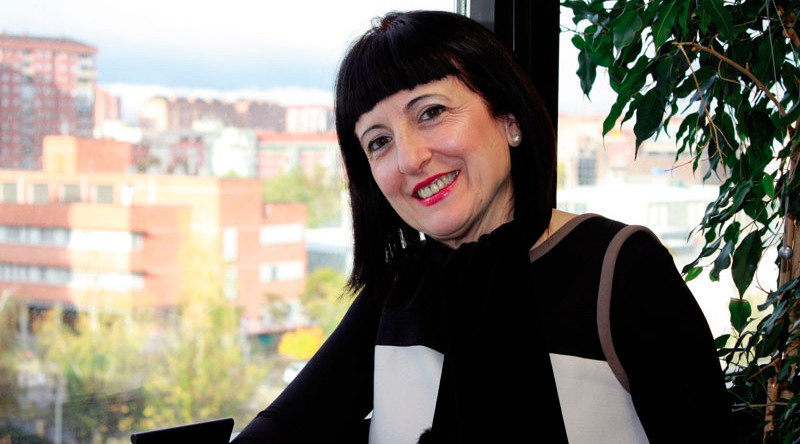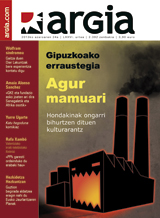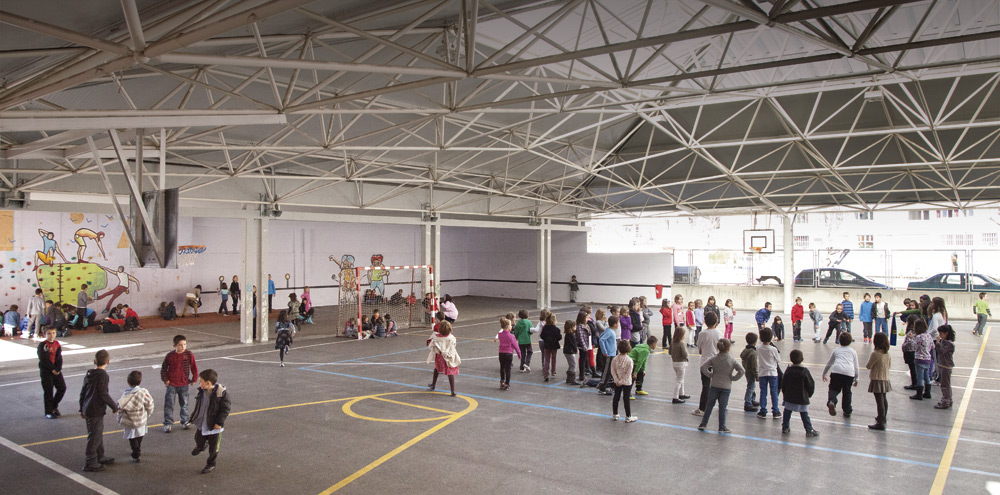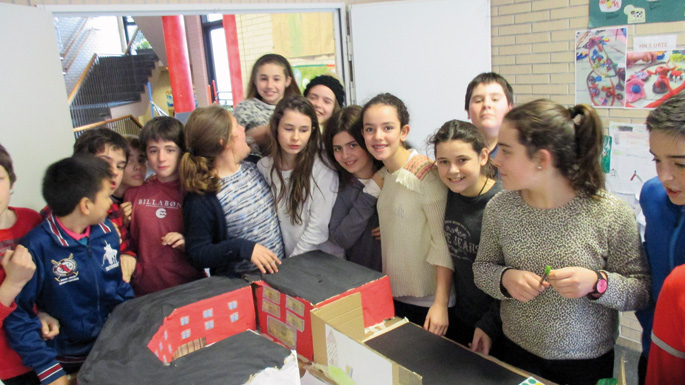Time to address the issue of co-education from mixed school
- The Master Plan for Co-Education and Prevention of Gender Violence of the Basque Government aims to take the leap to the real implementation of the equality recognized in the law. So that each student develops in their entirety and not in function of their condition as children. “Teachers and parents are in favor of equality and we treat students in the same way. What else is missing?” Are you sure that the situations you consider normal are normal?

“The objective of the Department of Education, Linguistic Policy and Education is the student,” says the Director of Educational Innovation of the Basque Government, Begoña Garamendi. The plan aims to achieve a real transformation of the entire educational community for three years. In Garamendi’s words, there are many small details that show that equality is not a reality: “Analyze, if not, what images we have on the walls, what messages we transmit in the contents of the resume or how we organize the spaces of the center (for example, the football fields are the ones that dominate the playgrounds)”.
At the Elorrio Institute, we seek professors with experience in the field of co-education and who analyze the plan from the reality of the classroom. Agurtzane Berriozabal Bernas, head of studies, has brought together feminist theories and classroom practice: “Since the creation of the Seminar on Co-education at the Berritzegune in Bilbao three years ago, we have participated in it. This year we are going to ask to be one of the 50 centres that will receive training. Therefore, the work done so far on a voluntary basis will now be formalised.” It clearly explains the strength and risk of the Plan: “As any plan is ambitious: it sets the course and makes it feel that it is a task for the whole of society. And not a few, a few crazy. But if there's a risk, it's to stay in the roles, in the formal sense, and not take advantage of the situation to do something alive, to get really involved. Putting this into practice requires a way of being in life.”
Changing yourself, animating laws
Gender violence is the tip of the iceberg that shows the bottom sexism. Garamendi explained that all forms of gender-based violence must be addressed: “They are often considered normal. ‘They’ve touched our ass. The game is like this,” the students say and you have to answer them ‘they will touch you if you want’. No, that game isn't. You let it be that way.’ When a person feels bad, even if others find it stupid, they have to be taken into account and analyzed. Strategies must be devised so that abusive behaviors among peers that occur from the first years are absolutely rejected, educational centers perform analysis and organize actions to prevent sexual harassment.”
Berriozabal coincides with the detection and eradication of microviolence: “If this plan has something good, it’s that it changes the way you see and analyze situations, it’s about wearing purple glasses. What you can't see doesn't exist. Many times they are ‘things between boys and girls’, ‘it is a reflection of society’... they are explicitly covered and justified. They must be made visible and seen below are the foundations of sexism and gender violence. It's about micro-violence, insults, blows in the head as it passes, nudges, or nicknames. They are not allowed and tolerance must be zero. Students must learn that what is normal for them is not normal. That must be clearly stated. But you have to talk, it doesn't end with 'not playing'. You have to look at what happens, how the other feels, how he wants to be treated. This takes a long time in school and you have to recognize the same weight as subjects. Otherwise nothing will be solved.” As Berriozabal explained, the purple glasses covered by the plan should be used by oneself: “You have to put your head and your eyes on that. If you're just going to teach your lesson, you won't realize it. But the teacher is always an educator, and the other plus is to look with those eyes. The plan requires a change of self to be effective.” Garamendi stressed that this “self” is made up of eleven organisations: “The transformation is in the educational community. All actors must be involved. We are talking not only about teachers and students, but also about the administration, educational institutions, families, the Berritzegunes, the inspectors, the ISEI-IVEI and the other departments of the Basque Government: Emakunde (in this plan we have the support and assistance of Emakunde), Foral Deputies, Eudel, Berdindu, Osakidetza and women’s associations from other ethnic and cultural backgrounds. The Plan defines the role of each agent.”
The key to transforming people is training. Berriozabal raises the main question: “How do you extend the training that you receive to the whole center?” He has stressed the importance of proactive leadership on this issue, “so that through leadership teachers can take it to this task”. Garamendi insists that this will be the key: “Each center should decide how to carry out the whole process. This is an internal organization that must be agreed upon by the members of the community. But it's known that if training stays only in one person, it's not enough. 60% of the teachers will be sensitized, but it is essential to change the personal chip and incorporate this vision in the classrooms, in the educational centers, in the dynamics”. Awareness will reach all schools, and Garamendi has ensured that they will be offered all the resources and tools to work on co-education. Although the involvement of the individual is key, it does not undermine the strength of the laws: “The law contributes a lot to individual motivation. It gives it seriousness. For example, if this training is requested in job profiles, people are prepared. Otherwise ‘today I cannot and tomorrow’, everything remains in the hands of one’s own will.”
Students should be trained
The plan recognizes the school as a strategic space for equality in society. However, in the daily life of the students, everything extracurricular has a great weight. How do we get co-educational work at school to work for life? More than in the professors' discourse, Berriozabal has emphasized the students: “The main function of the School is to form a critical opinion in students. You have to help them analyze the bombardment they suffer through the media with criteria like series, advertising, ways of relating, fashion... They have to learn to say no in the different situations they live in. And above all, they have to learn how to detect discrimination and sexism on the social media that they use. For us, that world is an ocean that we know superficially. If we don't prepare students to analyze things, we can't do anything about it. We cannot enter their world because the opposite effect is often achieved.”
Espektatibak dira gakoa. Zer portaera, zer jarrera, eta zer etorkizun profesional espero dugun nesken edo mutilengandik. Espektatiba horien arabera tratatzen ditugu umeak urtetan, Agurtzane Berriozabal Elorrioko institutuko irakasleak azaldu duenez: “Irakasleek pentsatzen dute berdin tratatzen dituztela beraien ikasleak neska edo mutilak izan, nahiz eta ikerketek demostratu denbora gehiago eskaintzen zaiela mutilei neskei baino”. Gizarteak eurengandik espero duenari erantzunez, jarrera eta gaitasun desberdinak lantzen dituzte, eta honek lotura zuzena du eskola porrotarekin, Begoña Garamendi Hezkuntza Berriztatzeko Zuzendariak ohartarazi duenez: “Mutilek neskek baino emaitza akademiko kaskarragoak dituzte. Mutilek landu dituzten jarrerak lotuago daude jokabide suntsitzaileekin, diziplina arazoekin, gatazkak konpontzeko trebetasun faltarekin... Neskei erakusten zaie esanekoak, zintzoak izaten, ikaskideei laguntzen... Mutilei, aldiz, iniziatiba hartzen, ekintzaileak izaten... Batzuen eta besteen alde positiboak aukeratzen irakatsi nahi diegu. Eta horiek guztien artean lantzea pertsona osoa izateko”. Berriozabalek azaldu du emaitza akademikoak ezberdin interpretatzen ditugula sexuaren arabera: “Nesken emaitzak askotan hobeak dira, baina lanarekin lotzen dira, ‘langileagoak direnez emaitza hobeak lortzen dituzte’ esaten dugu eta ez dugu hainbeste lotzen gaitasunarekin. Aldiz, mutilekiko dugun pertzepzioa da ‘ez dira langileak baina azkarragoak dira eta gero nabarmentzen dira bizitzako lanetan, munduan’”.
Urtetan erantzundako espektatiba horien ondorio dira gaztaroan neskek eta mutilek egiten dituzten ikasketen hautuak, Garamendik azaldu duenez: “Batxilergoan mutil gehienek bide zientifiko-teknologikoa hartzen dute eta neska gehienek gizarte zientzia alorreko bidea. Aukera horrek baldintzatzen ditu geroko ikasketak (bai unibertsitatean eta bai lanbide heziketan). Eta gerora norberaren bizitza eta lan aukerak baldintzatzen dira”. Berriozabalek berdintasunaren anfora hautsi du: “Berdintasuna lortu denaren irudikapena oso zabalduta dago. Ikasleek uste dute erabakiak libreki hartzen dituztela ikasketak aukeratzerakoan, baina ikasketa batzuk oraindik mutilen edo nesken gauza dira”.
Datozen hiru urteko epean lortu beharreko emaitzak kuantifikatu ditu planak eta horretarako baliabideak jarri. Hauek dira helburuak eta baliabideak:
- Irakasleen %60ak oinarrizko sentsibilizazioa jasotzea (10 orduko modulua): irakaslea sentiberatzea hezkidetzan, aniztasun afektibo-sexualean eta genero indarkeriaren prebentzioan.
- Aurten bertan ikastetxe guztietan hezkidetzako irakasle arduradun bat eta Organo Gorenean berdintasun-ordezkaria izendatuko dira. Eta berdintasuneko batzordea sortuko da. Irakasle arduradunek batez beste asteko hiru orduko liberazioa izango dute funtzio hau betetzeko eta eskualdeko mintegietan parte hartzeko aukera izango dute, formaziorako.
- Aurten 50 ikastetxe publikoetan eta datozen bi urteetan publiko zein itunpeko ikastetxeen %30ak berariazko prestakuntza jasotzea eta hezkidetza eta genero indarkeriaren prebentzioa sustatzeko proiektu bat gauzatzea: lehenik ikastetxearen diagnostikoa egingo dute eta ikasturtero lan plan bat eta beronen memoria egingo dute. Ikastetxearen urteko planean eta urteko memorian hezkidetza ikuspegia txertatu beharko dute.
- Hurrengo ikasturtean hamar ikastetxe pilotutan proiektu integralak garatuko dira. Hezkidetza ikuspegia txertatua duen funtzionamendua izango dute ikastetxe horiek, bai alde curricularrean eta baita antolamenduan ere. Hamar ikastetxe hauek gainerakoentzat erreferentziazkoak izango dira, eredu izango ditugu.
- Hurrengo ikasturtean Genero eta gizarte aldaketa hautazko ikasgaia izango da Bigarren Hezkuntzako 4. mailan eta Batxilergoan. Erreferentziazko hamar ikastetxe horietan hasiko dira eta gainerakoetan, nahi duten ikastetxeei aukera emango zaie ikasgai hori eskaintzeko. Administrazioak curriculuma diseinatuko du.
- Aurten zerbitzu estrategikoetan (Hezkuntza Berriztapen Zuzendaritza diren Berritzegunetan, Ikuskaritzan, ISEI-IVEI institutuan), hezkidetzako eta genero-indarkeria prebenitzeko arduradun bat izendatuko da. Zerbitzu estrategiko hauetako bakoitzean lanpostu bat egongo da, zeinaren esleipenerako ezinbestekoa izango den hezkidetzan, berdintasunean eta genero indarkeriaren prebentzioan gaitua egotea, unibertsitatearen edo administrazioaren 150 orduko prestakuntzaren ziurtagiria izatea.
- ISEI-IVEIk ikerketa diseinatuko du, eskola ereduaren garapenari jarraipena egiteko.
- Tutoretza eta orientazio planetan genero ikuspegia txertatu beharko da.
- Ikasmaterial gomendagarrien eta saihestu beharrekoen erreferentziak emango zaizkie ikastetxeei. Eta material sexistei buruzko kexak bideratzeko prozedura zehaztuko da. Material ez sexistak lantzen dituzten argitaletxeei ziurtagiriak banatuko zaizkie. Garamendiren hitzetan, “material onak definitzeko hauek dira Hezkuntza Sailaren irizpideak: familia ereduen, sexu identitateen eta kultur ezberdinetako emakumeen aniztasuna islatzea, erantzunkidetasunean eta arretan oinarritutako harremanak aintzat hartzea eta arlo akademikoen orientabidean aniztasuna bultzatzen duten materialak izatea”.
- Indarkeria mota desberdinak antzemateko adierazleak finkatuko dira eta bete beharreko jarduera protokoloak zehaztuko dira.
Txano-gorritxo otsoaz maitemindu zenekoa izendatu zitekeen gaurko neska mutilen arteko harremana. Garamendik azaldu duenez, “kuriosoa da baina horrela da: sexu indarkerien subjektua norberak harreman afektibo-sexualak izateko libreki hautatutako pertsona da. Hainbat ikerketetan agertu da eredu agresiboa erakusten duten pertsonen hautu kontzientea egiten dela. Pertsona horiek desiragarritzat hartzen direla. Gazte askok ez dituzte patroi tradizionalak (nagusitasuna eta jabetasunean oinarritzen diren patroiak) gaitzesten. Nahiz eta ohartzen diren ez direla berdintasunean oinarritutako harremanak. Askotan patroi tradizionalak erakargarriak direla iruditzen zaie, are gehiago, berdintasunean oinarritutako jarrerak ez dira behar adina erakargarri izaten. Neskek garrantzi handia ematen diote maskulinitate irudi tradizionalari, alegia, berdintasunean oinarrituta ez dauden balio eta jokabideei eta mutilek gauza bera egiten dute feminitate irudi tradizionalarekin”. Gaiztoa/desiragarria binomioa haustea da kontua. Horixe baitu arazoak alde onena: erakarpena, desioa eta gustuak eraiki eta eraldatu egiten direla familian, ikastetxeetan, lagunartean eta hedabideetan. Eta beraz, aldatu daitezkeela. Berriozabalek jokoa hausteko klabea eman digu: “Balioan jarri behar da gaiztoak ez diren mutilek dutena eta hauek bihurtu behar dira desiragarri”. Garamendik nola egin aholkuak eman ditu: “Ikasleekin aztertu behar da zer mutil motak erakartzen dituen, zergatik gertatzen den hori, zein balore dituzten... Euren jokabideen ondorioez hausnartzen lagundu behar diegu”. Berriozabalek azaldu du urteak badirela Elorrioko Udaleko Berdintasun teknikari Maitane Iribarrekin batera, Tratu onen tailerra edo Eraldatzen tailerra lantzen dutena: “Tailer hauek jende gazteak ematen ditu eta eurak gehiago heltzen dira ikasleengana. Horrela mezua eraginkorragoa dela iruditzen zaigu”.
Bikotetik kanpo ere harreman afektibo-sexualetan ikuspegi matxista dela nagusi azaldu du Berriozabalek: “Mutilak zenbat eta gehiago ligatu edo neskekin sexu harremanak izan hobe, desiragarria izango da, neskak jokabide horrekin permisiboak dira. Neskak harreman asko baditu ‘emagaldua’ dela esango dute, ez da mutilen ideala. Eta bestetik homofobia ere antzematen da: mutilei ‘marikoia’ esango diete eta nesken kasuan izendatu ere ez da egiten, lesbianismoa ez da existitzen”.
Irailetik aurrera, eta hala eskatzen duten ikastetxeetan, genero berdintasunari buruzko ikasgaia izango dute 12-14 urteko ikasleek Galizian. Astean ordubeteko iraupena izango du eta erabaki aitzindaria da Espainiako Estatuan.
aukeratzeko gidak Lekeition
Gabonak datozela eta ipuin eta jostailu ez sexistak aukeratzeko gidak argitaratu ditu Lekeitioko Udalak. Hainbat liburu eta jostailuren bidez genero estereotipoak transmititzen dira. Baina berdintasunean oinarrituriko baloreak zabaltzeko material ugari dago, horietako asko... [+]
Eusko Jaurlaritzako Hezkuntza sailak hezkidetza lantzeko eta eraso sexistei aurre egiteko plana jarriko du martxan EAEko ikasgeletan. Besteak beste, “genero eta gizarte eraldaketa” ikasgaia bultzatuko du.





















